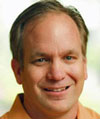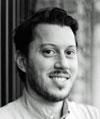| |
|
|

|
|
ATLAS |
|
|
Assistive
Technology
Laboratory
at
Stanford |
|
|
|
Technology
and design benefitting individuals with disabilities and older adults in the
local community |
February 19, 2016 |
|
|
|
|

Perspectives is the newsletter of the
Stanford course,
Perspectives in Assistive
Technology.
This issue invites you
to attend the next class lecture.
Perspectives in Assistive Technology is a Winter
Quarter Stanford course - now in its tenth year - that explores the design,
development, and use of assistive technology that benefits people with
disabilities and older adults. The schedule
consists of semi-weekly classroom discussions; lectures by
notable professionals, clinicians, and assistive technology users; tours
of local medical, clinical, and engineering facilities; an assistive
technology faire; and a film screening.
Next class
session - Tuesday, February 23rd at 4:45pm
|


|
Perspectives on Bringing New
Assistive Technology Products to Market
Robert Karlovich
CEO and
Founder of Core Mobility Solutions, Inc.
Ahmad Al-Ghazi
CEO and Founder of CAN Mobilities |
|
Abstract: These
two inventors will present their efforts and experiences in bringing their
innovative designs to commercialization. |
|
Robert Karlovich's
Biosketch: Rob Karlovich has more than twenty-five years of product
design, solution development, and global sales and business leadership
experience within the computer, communications and healthcare industries. Rob
is a natural innovator who understands how to guide solution development from
conception to large scale adoption. Rob holds seven US utility patents. Rob
launched the LifeGlider Project in April 2012 with the commitment to develop
solutions to address deficiencies in current assistive technologies for
standing and walking. The culmination of the project is the establishment of
Core Mobility Solutions, Inc. |
|
Ahmad Al-Ghazi's
Biosketch: Ahmad Al-Ghazi is a serial entrepreneur. He gained a wide
range of experiences building products and companies in industries such as
hardware, software, design, and media. Furthermore, Ahmad was the creator of
the award-winning mobility aid device, GOOM, that helps seniors to stand, sit,
and walk independently. His work on developing GOOM led him to be selected, out
of seven thousand applicants, as a winner of “Stars of
Science,” a popular Middle Eastern scientific reality TV show. He is
the inventor of five US and international issued and pending patents. He
received his MS degree in Engineering Management, with a minor in Software
Engineering, from Santa Clara University. He holds a BS with honors in
Production and Mechanical System Design. Recently, he completed the Stanford
Graduate School of Business
Ignite
Program focusing on Innovation and Entrepreneurship. He was featured in
local and international media for the innovative products and
startups. |
|
Suggest a project -
Good assistive technology project suggestions are sought for Stanford's
Mechanical Engineering capstone course (ME113) for the upcoming Spring Quarter.
Your suggestions should be based on an observation or experience of a real
challenge faced by individuals with a disability or older adults.
Projects will involve the design and fabrication of a
functional solution to the problem, as well as student team presentations and
reports.
This is a great opportunity for individuals,
organizations, or companies to interact with teams of talented, enthusiastic
seniors, benefit from their fresh perspective, and gain access to university
expertise and resources. Students benefit by having the opportunity to apply
their studies of solid and fluid mechanics, manufacturing, and mechanical
design to a real world problem.
Your first step is to visit the
Project Solicitation webpage for a list
of project requirements and a description of how best to convey your ideas. If
your suggestion is accepted, you will have the opportunity to offer the student
team advice, direction, and expertise in person or by phone and/or
email. |
 |
|
|
Attend a lecture -
Course lectures will be held on Tuesdays
and Thursdays from 4:30 to 5:50pm and are open
to the greater Stanford community. You are most welcome to sit in on class
sessions that interest you. You need not be a Stanford student and there is no
required signup, enrollment, or charge. The class will meet in a large, tiered,
accessible classroom on campus in the Thornton Center, adjacent to the Terman
Fountain and near the Roble Gym, the same venue as last year. Here are the
parking options, maps, and directions to
the classroom. |
 |
|
|
Did you miss a
lecture? - Course lectures are posted on YouTube. To find the links,
browse to the Lecture Schedule webpage,
scroll down and click on the lecture of interest. Near the bottom of the page
you will see the Lecture Material section which has links to the slides,
photos, weblinks, and lecture video. |
 |
|
Would you like to support the
course? - Funding in any amount for the course and student projects
is always welcomed. Monetary gifts support approved project expenses,
administrative costs, honoraria for guest lecturers, and the end-of-term
celebration. Refer to the Team Project Support
webpage for more information.
Do you have a question,
comment, or suggestion? - If you have general questions, comments,
or suggestions about the course, David L. Jaffe, MS, the instructor, can
be reached by email or at
650/892-4464. Thank you again for your interest in the course.
Dave
|

To unsubscribe from this newsletter, please email
Dave. |
|








